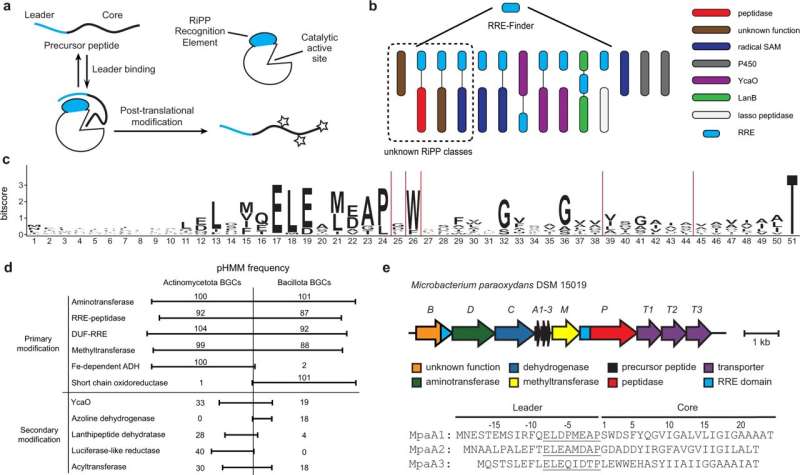
Living organisms produce a myriad of natural products which can be used in modern medicine and therapeutics. Bacteria and other microbes have become the main source for natural products, including a growing family called ribosomally synthesized and post-translationally modified peptides, or RiPPs. The labs of Douglas Mitchell (MMG), John and Margaret Witt Professor of Chemistry, and Huimin Zhao (CABBI/BSD/GSE/MMG), Steven L. Miller Chair of Chemical and Biomolecular Engineering, at the University of Illinois Urbana-Champaign have been working in tandem to identify and analyze new RiPPs that could be good candidates for drug development and therapeutics.
"Compared to other classes of natural products such as alkaloids, terpenes, or polyketides, RiPPs are still underexplored, partly because their biosynthetic gene clusters are quite small and were often overlooked in the past," said Zhao. "So we decided to develop new technologies to discover novel RiPPs with biological activity."
"Now that we're in the genomics era, we're realizing just how widespread these groups of natural products are, especially in bacteria," said Shravan Dommaraju, a Ph.D. candidate in Mitchell's lab. "We're basically in this exploration phase, where we know that they're out there, and the goal is to see how many we can find because we don't know what they all do yet."
In a new paper by the Zhao and Mitchell labs, with co-first authors Dommaraju and Hengqian Ren, a postdoctoral researcher in Zhao's lab, the team reported the discovery of a unique, novel class of RiPPs, which they have named "daptides." Unlike most peptides which have one positively charged and one negatively charged end, or "terminus," daptides instead have two positively charged termini.
"A textbook would say that a peptide has an amino terminus and a carboxy terminus, but in our case, we found a ribosomal peptide that has two amino termini," said Ren. "Because there's positive charge at both ends, this gives daptides some interesting bioactivities."
The researchers explained that while this change in termini may seem small, the positive charge of both termini gives daptides the potential to interact with negatively charged objects, such as cell membranes. To test this, the team added the daptides to a dish with red blood cells. They found that the daptides showed hemolytic activity, meaning that they disrupted the membranes of the cells, causing them to rupture. Zhao explained that hemolytic activity is rarely found in the RiPPs the team works with, and that antimicrobial or antifungal activity is much more common.
"We were thinking about the structure and what is the evolutionary drive to cause a peptide to lose the negatively charged C terminus and replace it with a positively charged amino group," Dommaraju said. "From an engineering perspective, if you wanted to make a peptide that can interact with a membrane, you would stick a bunch of positive charges on it. And that's actually what led us to testing this for hemolytic activity because we knew that it had this modification that should allow for that."
Finding new RiPPs is no easy task. First the researchers use bioinformatics to compare and try to identify gene clusters that could produce potential RiPPs. Then they clone the targeted cluster and place it into an organism to be expressed, after which they can check for any natural products produced. Even after obtaining the products, there is still the question of what the products do and how they are produced, which can be tested with bioassays, gene knockouts, and a variety of other tests. But Dommaraju says the labs each play to their expertise when collaborating to streamline the process.
"So on a project like this, the Mitchell lab does the bioinformatics and identifies cool gene clusters, and the Zhao lab gets the synthetic biology system up and going to express these peptides and make them," Dommaraju explained. "So then we are able to tag team our experience and the overlapping stuff that we do to get the project to the finish line."
The researchers say the next steps are to understand the enzyme functions of the daptides, and use bioinformatics analysis to see if there are other combinations of genes associated with daptide production. Directions for further studies in the future include exploring potential therapeutic uses for daptides, and the ecological role that daptide production has for the bacteria that make them. However, both Ren and Dommaraju agreed that their interests in future experiments with RiPPs extends beyond just daptides, as there are still more classes to discover.
"We're interested in using our bioinformatics tool to find as many different natural product classes as we possibly can," said Ren. "There is such a large frontier right now of undiscovered RiPP classes, and it's exciting to be at the cutting edge, discovering new possibilities. There's always a chance that the next product you find might be a major therapeutic development!"
The paper is published in Nature Communications.
More information: Hengqian Ren et al, Genome mining unveils a class of ribosomal peptides with two amino termini, Nature Communications (2023). DOI: 10.1038/s41467-023-37287-1
Provided by University of Illinois at Urbana-Champaign
Citation: Researchers discover new class of ribosomal peptide with hemolytic activity (2023, April 5) retrieved 5 April 2023 from https://ift.tt/nSiTlDv
This document is subject to copyright. Apart from any fair dealing for the purpose of private study or research, no part may be reproduced without the written permission. The content is provided for information purposes only.
"activity" - Google News
April 05, 2023 at 03:19PM
https://ift.tt/cCIJDUp
Researchers discover new class of ribosomal peptide with hemolytic activity - Phys.org
"activity" - Google News
https://ift.tt/D7tPVO8
https://ift.tt/nqK8pbA
Bagikan Berita Ini














0 Response to "Researchers discover new class of ribosomal peptide with hemolytic activity - Phys.org"
Post a Comment